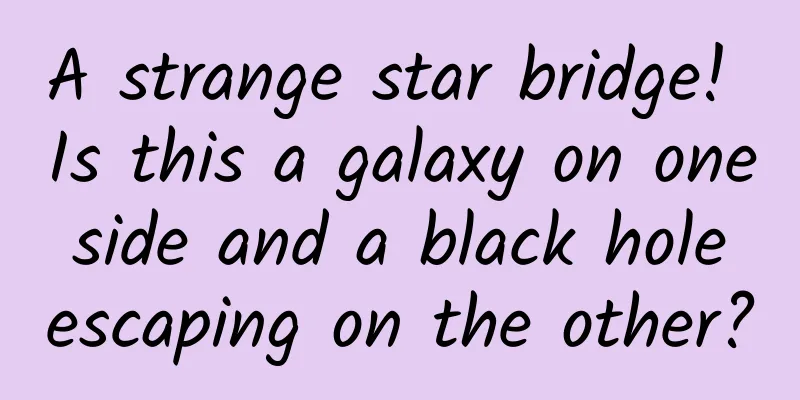A strange star bridge! Is this a galaxy on one side and a black hole escaping on the other?

|
Bumper ball game between black holes Scientists define a supermassive runaway black hole (lower left) as one that is ejected from its host galaxy and compresses tenuous gas as it travels through intergalactic space, triggering the birth of new stars and thus forming a long star bridge between the black hole and its host galaxy. Image credit: Hubble-Saithe/NASA/Leah Hustak (STScI). Hubble-Sette said that on April 6, 2023, scientists discovered a 200,000 light-year-long star bridge. It is hot, young, contains many blue stars, and its diameter is twice that of our Milky Way. This star bridge, located halfway across the universe, between an escaping supermassive black hole and a galactic black hole is stretching. Astronomers believe that the escape of the black hole causes the gas to compress along its wake, creating new stars and star bridges in the process. Hubble-Sette said that such a star bridge has never been observed before. This escaped black hole is like an invisible monster, quickly passing through interstellar space. If it is located in our solar system, it can reach the moon from the earth in 14 minutes. This supermassive black hole is about 20 million times the mass of the sun. After passing through interstellar space, it left behind a 200,000 light-year-long tail that has never been discovered by humans. This tail contains a large number of new stars, like the result of a very rare strange billiard game between three supermassive black holes. Yale astronomer Peter and his colleagues observed the star bridge using the Hubble Space Telescope. They believe their explanation is plausible, even though no one has ever observed such a bridge. The peer-reviewed study of the black hole hypothesis was published in the journal Astrophysical Journal Letters on April 6, 2023. A black hole with a star trail Hubble-Seth said that the universe is so unpredictable that even the smallest unnoticed things can have far-reaching consequences. That's what happened to Pete. While analyzing Hubble Space Telescope images, he noticed a suspicious mark that looked like a scratch. To Hubble's electron camera, the cosmic rays showed up in the detector like a "scratch," but once the strange streak in the spectrum was analyzed, Pete realized it was actually a chain of young blue stars 200,000 light-years long... Unlike a black hole that devours stars in front of it like a cosmic Pac-Man, a high-speed black hole ejects gas outward, triggering the birth of new stars in a narrow strip in the direction of the ejection. "We think we are seeing a trail where gas ejected from the black hole has cooled to form stars, so what we are observing is the result of star formation after the black hole has passed by, just like the trail left by a ship passing by, we are seeing the trail left by the black hole as it passes through interstellar space," Vant'Dom said. Since the trail is half as bright as its host galaxy, it is thought to contain many new stars. Star Bridge was an unexpected discovery Vant'Dom said he wasn't observing a black hole or new stars when he found Starbridge, but rather he was observing a globular cluster of stars near a dwarf galaxy. "It was discovered purely by accident. I was looking at images taken by the Hubble Telescope and suddenly noticed some streaks in the image. I thought maybe cosmic rays hitting the camera detector created this linear image, but when we removed the effect of cosmic rays, we found that the streaks were still there, unlike anything we had seen before." Because the streak was so strange, Vant'Dom and his team conducted ground-based spectroscopic observations at the W. M. Keck Observatory in Hawaii. The results were quite surprising, and he found that the star bridge was very bright and very unusual. After this additional analysis, the team speculated that what they observed was the wake created by a black hole passing through the gas ring around its host black hole. This archival Hubble Space Telescope photo captures a bizarre and unusual chain that was thought to be an artifact of Hubble's first imaging camera. But subsequent space observations revealed it to be a 200,000-light-year-long chain of young, blue stars. Astronomers think a supermassive black hole is at the top of the bridge (lower left of frame), and that the black hole was ejected from its host galaxy at the upper right, compressing gas in its wake to form a string of young, blue stars. Nothing like this has ever been seen before in the Universe, and this unusual event occurred when the Universe was about half its current age. Image credit: NASA/NASA/Pete Vant'Dom (Yale University)/Joseph DePasquale (STScI). Multiple collisions between supermassive black holes Astronomers believe that the black hole and its trail of stars originated from the merger of two galaxies, each of which contained a supermassive black hole at its core. They believe that perhaps the two galaxies began to merge 50 million years ago, so the two supermassive black holes at the core of the galaxies also merged together to form twin black holes. Then another galaxy with a supermassive black hole at its center appeared. Among the three nearby black holes, one of them took away the momentum of the other two, making the overall structure very unstable. When it reached a certain critical point, with a bang, the black hole was driven out of the host galaxy. Scientists say either the early twin black holes remained intact, or the new intruder replaced one of the twins and kicked it out. When this black hole is "kicked out" somewhere, the twin black hole is ejected in the opposite direction, and the runaway twin black hole may be seen on the other side of the host galaxy. Indirect evidence is that there is no sign of an active black hole at the core of the host galaxy. The next step is to confirm this hypothesis of a black hole through observations with NASA's James Webb Space Telescope and Chandra X-ray Observatory. Will we discover more star bridges in the future? Like many astronomers, the scientist also mentioned the upcoming Nancy Grace Roman Space Telescope, which will be launched in May 2027 and will be as sharp as the Hubble Space Telescope while trying to see the universe through a wide angle. As a survey telescope, the Roman observation point may be able to find more of these rare, seemingly unreal streaks of stars in the universe. This may require machine learning using algorithms that are good at finding specific shapes in a sea of other astronomical data. Bottom line: Scientists have discovered a 200,000-light-year-long chain of young, blue stars - a star bridge halfway across the universe - connecting a runaway black hole and the host galaxy from which it escaped. BY: Deborah Byrdand FY: All sorts of things If there is any infringement of related content, please contact the author to delete it after the work is published. Please obtain authorization for reprinting, and pay attention to maintaining integrity and indicating the source |
>>: It’s no exaggeration, people can really be “angered to death”!
Recommend
Tik Tok is popular, Yinyue is hot: How are Toutiao’s hit products created?
Popular products cannot be copied, but the logic ...
377 kilometers, 253 bridges, 159 tunnels... Why is this high-speed railway so difficult?
At 10:18 on December 22, 2010, the No. 4806 train...
6 creative information flow formulas to solve the pain points of users in the loan industry one by one!
Place information flow ads , I examine myself thr...
How powerful is the Tabor robot vacuum cleaner’s path-finding artificial intelligence laser navigation + PC-level chip?
Some time ago, "AlphaGo" defeated Lee S...
Samsung S5 screen test
Bulgarian website Smartphone.bg praised the Galaxy...
Why do humans want to explore asteroids?
Asteroids are celestial bodies that orbit the sun...
A must-learn typography tutorial for new media beginners: 3 functions and 10 tips
Now is an era where everyone has a public account...
The famous female singer's condition worsens! She can no longer "control her muscles". What is Stiff-Person Syndrome?
It has been a year since the famous singer Celine...
After the rules of the game for new energy vehicles have changed, Korean batteries are having a hard time gaining a foothold
On March 30, the new energy vehicle battery facto...
The Ministry of Industry and Information Technology announced the removal of 48 apps that infringed on user rights
[[411025]] On July 12, the Ministry of Industry a...
Common methods for website promotion, what are the basic methods for website promotion?
Nowadays, many public account operators like to u...
What is life? The Turing test may give the answer
Currently, scientists don't really agree on a...
Baidu ocpc delivery operation skills
As the title says, 2021 has passed and we welcome...
[Daiyu Finance] Yan Fan Tactics Yan Style Tactics First Style Tutorial - Heaven and Earth are missing and holding a golden baby
[Daiyu Finance] Yan Fan Tactics Yan Style Tactics...
Changsha Tea Drinking and Tasting 2022 Audition Venue, Highly Recommended for You with Rich Nightlife
Changsha's 2022 tea drinking and tasting audi...









